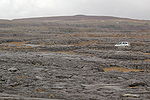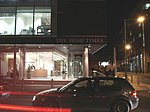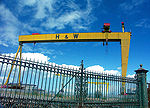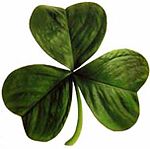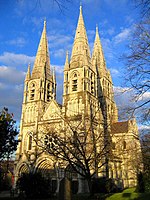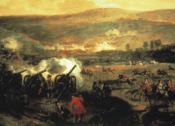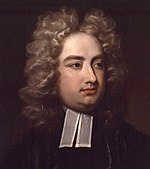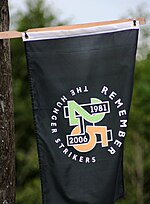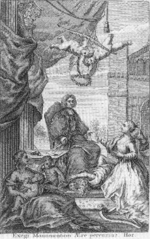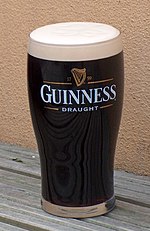Portal:Ireland/Selected article archive
Selected article archive
Selected article archive
Some of these articles about
Portal:Ireland/Selected article archive/1
Croagh Patrick (
Portal:Ireland/Selected article archive/2
The Ireland rugby union team, represents both the
Portal:Ireland/Selected article archive/3
The
Portal:Ireland/Selected article archive/4
Skellig Michael (from Sceilig Mhichíl in the Irish language, meaning Michael's rock), also known as Great Skellig, is a steep rocky island about 15 kilometres west of the coast of County Kerry, Ireland. It is the larger of the two Skellig Islands. For 600 years the island was an important centre of monastic life for Irish Christian monks. An Irish Celtic monastery, which is situated almost at the summit of the 230-metre-high rock, was built in 588, and became a UNESCO World Heritage Site in 1996. It is one of Europe's better known but least accessible monasteries.
Since the extreme remoteness of Skellig Michael has until recently discouraged visitors, the site is exceptionally well preserved. The very spartan conditions inside the monastery illustrate the ascetic lifestyle practiced by early Irish Christians. The monks lived in stone 'beehive' huts (Portal:Ireland/Selected article archive/5
The Clàrsach (
The earliest descriptions of a European triangular framed harp i.e. harps with a fore pillar are found on 8th century Pictish stones. Pictish harps were strung from horsehair. The instruments apparently spread south to the Anglo Saxons who commonly used gut strings and then west to the Gaels of the Highlands and to Ireland. Historically the carvings were made in the period after the establishment of the Gaelic kingdom of
Portal:Ireland/Selected article archive/6
Portal:Ireland/Selected article archive/7
The bodhrán (IPA [ˈbɔːrɑːn] or [ˈbaʊrɑːn]; plural bodhráns or bodhráin) is an Irish frame drum ranging from 25 to 65cm (10" to 26") in diameter, with most drums measuring 35 to 45cm (14" to 18"). The sides of the drum are 9 to 20cm (3½" to 8") deep. A goatskin head is tacked to one side (although nowadays, synthetic heads, or new materials like kangaroo skin, are sometimes used). The other side is open ended for one hand to be placed against the inside of the drum head to control the pitch and timbre. One or two crossbars, sometimes removable, may be inside the frame, but this is increasingly rare on professional instruments. Some professional modern bodhráin integrate mechanical tuning systems similar to those used on drums found in drum kits. Read more...
Portal:Ireland/Selected article archive/8
The executions during the Irish Civil War took place during the guerrilla phase of the Irish Civil War (October 1922 – May 1923) This phase of the war was bitter and both sides, the Government forces of the Irish Free State and the Anti-Treaty IRA insurgents, used executions and terror in what developed into a cycle of atrocities. From November 1922, the Free State government embarked on a concerted policy of executing Republican prisoners in order to bring the war to an end. Many of those killed had previously been allies and in some cases close friends (during the Irish War of Independence 1919–1921), of those who ordered their deaths in the civil war. In addition, government troops summarily killed prisoners in the field on several occasions. The executions of prisoners left a lasting legacy of bitterness in Irish politics.
The use of execution by the Irish Free State in the civil war was relatively harsh. By contrast with their 77 official executions, the British had executed only 14 IRA volunteers during the War of Independence. One of the reasons for the draconian Free State policy from October 1922 was the death ofPortal:Ireland/Selected article archive/9
Derry or Londonderry (Doire or Doire Cholm Chille in Irish), often called the Maiden City, is a
Portal:Ireland/Selected article archive/10
The Burren (
Portal:Ireland/Selected article archive/12
The Orange Institution, more commonly known as the Orange Order or the Orange Lodge, is a
Portal:Ireland/Selected article archive/13
The Irish Times is an Irish daily broadsheet news paper launched in the late 1850s. The current editor is Geraldine Kennedy, who succeeded Conor Brady in 2002. The paper is generally perceived as liberal and neutral on Irish unity, in contrast to the Irish Independent, which is perceived as populist and economically right wing.
Though formed as a Protestant Irish
Today, its most prominent columnists include writer and arts commentator
Portal:Ireland/Selected article archive/14
Harland and Wolff Heavy Industries is a heavy industries and shipbuilders located in
Portal:Ireland/Selected article archive/15
Brú na Bóinne (
Portal:Ireland/Selected article archive/16
The shamrock, a symbol of the whole of
Portal:Ireland/Selected article archive/17
Fairytale of New York is a popular
Portal:Ireland/Selected article archive/18
'Modern Celts are peoples who consider themselves, or have been considered by others, to be Celts in modern times i.e. post 1800. However, the term is generally used for a number of peoples in Europe sharing various cultural traits and speaking
Portal:Ireland/Selected article archive/19
Saint Finbarre's Cathedral, also spelled Saint Fin Barre's Cathedral (Irish: Ardeaglais Naomh Fionnbarra) is a Church of Ireland cathedral located in Cork city, Ireland. The site of the cathedral has been a place of worship since the 7th century. The three spires of the cathedral are one of Cork's main landmarks. It is the seat of the Bishop of Cork, Cloyne and Ross, currently Bishop Paul Colton and is named after Cork's patron saint.
APortal:Ireland/Selected article archive/20
The Battle of the Boyne (Irish: Cath na Bóinne) was a turning point in the Williamite claim on the English throne. The deposed King James VII of Scotland and James II of England and Ireland and his Jacobite supporters were defeated by James' nephew and son-in-law, William III and his supporters. By the invitation of Parliament, William had deposed James in 1688. Both kings acted as commander of their respective armies.
The battle took place on July 1, 1690 (Portal:Ireland/Selected article archive/21
Portal:Ireland/Selected article archive/22

Portal:Ireland/Selected article archive/23
The history of Irish poetry includes the poetries of two languages, one in Irish and the other in English. The complex interplay between these two traditions, and between both of them and other poetries in English, has produced a body of work that is both rich in variety and difficult to categorise.
Towards the last quarter of the 20th century, modern Irish poetry has tended to a wide range of diversity, from the poets of the Northern school to writers influenced by the modernist tradition and those facing the new questions posed by an increasingly urban and cosmopolitan society. Read more...Portal:Ireland/Selected article archive/24
The Economy of the Republic of Ireland is modern, relatively small, and trade-dependent with growth averaging a robust 10% in

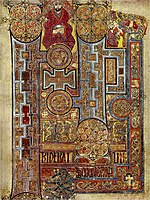

The geography of Ireland describes an island in northwest Europe in the North Atlantic Ocean. The main geographical features of Ireland include low central plains surrounded by a ring of coastal mountains. The highest peak is Carrauntoohil (Irish: Corrán Tuathail), which is 1,041 m (3,414 ft) above sea level. The western coastline is rugged, with many islands, peninsulas, and headlands. The island is bisected by the River Shannon, which at 259 km (161 s) with a 113 km (70 miles) estuary is the longest river in Ireland and flows south from County Cavan in the north to meet the Atlantic just south of Limerick. There are a number of sizable lakes along Ireland's rivers, with Lough Neagh being the largest.
Politically the island consists of the state Ireland and the UK constituent country Northern Ireland. Located west of the island of Great Britain, it is located at approximately 53°N 8°W / 53°N 8°W. It has a total area of 84,412 km² (32,591 mile²). It is separated from Britain by the Irish Sea and from mainland Europe by the Celtic Sea. Read more...
The 1981 Irish hunger strike was the culmination of a five-year protest during

The postage stamps of Ireland are issued by the
These were the major stamp productions for everyday use.
Portal:Ireland/Selected article archive/29
Áras an Uachtaráin (Irish pronunciation:
The original house was designed by park ranger and amateur
Portal:Ireland/Selected article archive/30
Irish dances can broadly be divided into
Irish performance dancing is traditionally referred to as stepdance. Irish stepdance, popularized in 1994 by the world-famous show "Riverdance," is notable for its rapid leg movements, body and arms being kept largely stationary. Most competitive stepdances are solo dances, though many stepdancers also perform and compete using traditional set and céilí dances. The solo stepdance is generally characterized by a controlled but not rigid upper body, straight arms, and quick, precise movements of the feet.
The dancing traditions of Ireland probably grew in close association withPortal:Ireland/Selected article archive/31
Queen's University Belfast is a university in
Queen's is a member of the
Portal:Ireland/Selected article archive/32
Irish whiskey (
At one time, all whisky was spelled without the extra 'e', as "whisky". In around 1870, the reputation of Scottish whisky was very poor as Scottish distilleries flooded the market with cheaper spirits produced using the Coffey still. The Irish and American distilleries adopted the spelling "whiskey", with the extra "e", to distinguish their higher quality product. Today, the spelling whisky (plural whiskies) is generally used for whiskies distilled in Scotland, Wales, Canada, Australia and Japan, while whiskey is used for the spirits distilled in Ireland and America.
Traditional Irish whiskey was distilled from a mash of mixed malted and unmalted grains whereas Scotch is either distilled exclusively from malted grain (hence "single malt"), or from unmalted grain. Today, most Irish whiskey is blended from a mixture of pot still whiskey and cheaper grain whiskey. Bushmills, however, is an exception, as it produces no Irish-style pot-still whiskey.
Most Irish whiskey is distilled three times, but so is some Scotch; thus it is a myth, although a common one, that this is the main distinction between the two varieties. Irish whiskey also differs in that peat is almost never used in the malting process, so the smoky, earthy overtones common to Scotches (particularly Islay Scotches) are not present except for the Connemara Peated Irish Malt whiskey from the Cooley distillery. Although Scotland sustains approximately 90 distilleries, Ireland has only three producing a number of different whiskeys. Read more...Portal:Ireland/Selected article archive/33
The Great Hunger (Irish: An Gorta Mór or An Drochshaol, litt: The Bad life) is a highly contentious period of history between 1845 and 1852 during which the population of Ireland was reduced by 20 to 25 percent. It is known by various names, such as The Great Famine in Ireland itself and The Irish Potato Famine internationally. The proximate cause of the famine was a pathogenic water mould, Phytophthora infestans, the disease it causes is commonly known as late blight of potato. Though P. infestans ravaged potato crops throughout Europe during the 1840s, its human cost in Ireland was exacerbated by a host of political, social, economic, and climatological factors which remain the subjects of heated historical debate.
The famine was a watershed in thePortal:Ireland/Selected article archive/34
Gaelic football (Irish: Peil, Peil Ghaelach, or Caid), commonly referred to as "football", "Gaelic", or "Gah" is a form of football played mainly in Ireland. It is, together with hurling, one of the two most popular spectator sports in Ireland today.
Gaelic football is played by teams of 15 on a rectangular grass pitch with H-shaped goals at each end. The primary object is to score by kicking/striking the ball with your hand and getting it through the goals. The team with the highest score at the end of the match wins.
Players advance the ball up the field with a combination of carrying, soloing (dropping and then toe-kicking the ball upward into the hands), kicking, and hand-passing to their team-mates.
Football is one of four
Sunday Bloody Sunday is the opening track and third single from U2's 1983 album, War. The song is noted for its militaristic drumbeat, simple but harsh guitar, and melodic harmonies. One of U2's most overtly political songs, its lyrics describe the horror felt by an observer of The Troubles in Northern Ireland.
The single was released in March 1983 in

In
Leprechauns and other creatures of Irish mythology are often associated with "faerie forts" or "faerie rings" — often the sites of ancient (Celtic or pre-Celtic) earthworks or drumlins.
They usually take the form of old men who enjoy partaking in mischief. Their trade is that of a

Battle of Tory Island was a naval action of the French Revolutionary Wars, fought on 12 October 1798 between French and British squadrons off the northwest coast of Donegal in Ireland. The last action of the Irish Rebellion of 1798, the Battle of Tory Island ended the final attempt by the French Navy to land substantial numbers of soldiers in Ireland during the war. It also ended the last hopes the United Irishmen had of receiving outside support in their struggle with the British.
In May 1798 thePortal:Ireland/Selected article archive/38
Aer Lingus is the flag carrier airline of Ireland founded in April 1936. Based at Dublin Airport, but originally operating out of Baldonnel Airfield, it operates 47 Airbus aircraft serving Europe, Africa and North America. The name, Aer Lingus is an anglicisation of the Irish form Aer Loingeas.
The airline is 29.4% owned by Ryanair and 25.4% owned by the Government of Ireland. It was floated on the Dublin and London Stock Exchanges on 2 October 2006, following prior government approval (the government previously owned 85% of the airline). Aer Lingus is a former member of the Oneworld airline alliance, which it left on 31 March 2007.
While Aer Lingus is not in an alliance it has codeshares with Oneworld, Star Alliance and SkyTeam members, as well as interline agreements with
The Irish Victoria Cross recipients lists all Irish-born recipients of the Victoria Cross, the highest war honour of the British Empire and the Commonwealth of Nations. Since 1881 it has been awarded to service personnel for extraordinary valour and devotion to duty while facing a hostile force. Between 1858 and 1881 the Victoria Cross could be awarded for actions taken "under circumstances of extreme danger" not in the face of the enemy. Six people were awarded Victoria Crosses under this clause until it was amended in 1881 to only allow acts "in the presence of the enemy". It was awarded to members of the British Armed Forces which included Irish service personnel until 1922. As of April 2008, 188 recipients are listed who were born in Ireland or had full Irish parentage.
Both
SS Irish Oak was a steamship chartered by Irish Shipping Limited in 1941, to transport wheat and fertilizer from North America to Ireland at a time when the country had few ships of her own. Sailing as a clearly marked neutral vessel, not in-convoy, she was torpedoed and sunk by U-607 on 15 May 1943 midway between North America and Ireland. The crew were rescued from their lifeboats by the Irish Plane about eight hours later.
At the time there were conflicting reports that she had not and allegations that she had warned a nearby convoy of the presence of a
Although the letters were condemned by the Irish government, with prompting from the British government, they inspired popular sentiment against Wood and his patent. This turned into a nationwide boycott, which forced the patent to be withdrawn; Swift was later honoured for this service to the people of Ireland. Many Irish people recognized Swift as a hero for his defiance of British control over the Irish nation. Beyond being a hero, many critics have seen Swift, through the persona of the Drapier, as the first to organize a "more universal Irish community", although it is disputed as to who constitutes that community.
The first complete collection of the Drapier's Letters appeared in the 1734 George Faulkner edition of the Works of Jonathan Swift along with an allegorical frontispiece offering praise and thanks from the Irish people. Some of Swift's other political writings are Gulliver's Travels, A Tale of a Tub, and A Modest Proposal. Read more...Portal:Ireland/Selected article archive/42
Guinness is a popular Irish dry stout that originated in the brewery of Arthur Guinness (1725–1803) at St. James's Gate, Dublin. Guinness is directly descended from the porter style that originated in London in the early 18th century and is one of the most successful beer brands worldwide, brewed in almost 50 countries and available in over 100 countries.
A distinctive feature is the burnt flavour which is derived from the use of roasted unmalted barley. For many years a portion of aged brew was blended with freshly brewed product to give a sharp lactic flavour (which was a characteristic of the original porter). Although the palate of Guinness still features a characteristic "tang", the company has refused to confirm whether this type of blending still occurs.
The thick creamy head is the result of the beer being mixed with nitrogen when being poured. It is popular with Irish people both in Ireland and abroad in spite of a decline in consumption since 2001, is still the best-selling alcoholic drink in Ireland. Read more...
The murder of Julia Martha Thomas dubbed the "Barnes Mystery" or the "Richmond Murder" by the press, was one of the most notorious crimes in late 19th-century Britain. Thomas, a widow in her 50s who lived in Richmond in southwest London, was murdered on 2 March 1879 by her maid, Kate Webster, a 30-year-old Irishwoman. Webster disposed of the body by dismembering it, boiling the flesh off the bones, and throwing most of the remains into the River Thames. Part of Thomas' remains were subsequently recovered from the river. Her severed head remained missing until October 2010, when the skull was found during building works being carried out for Sir David Attenborough.
After the murder, Webster posed as Thomas for two weeks, but was exposed and fled back to Ireland and her uncle's home atPortal:Ireland/Selected article archive/44
Irish whiskey (
The word "whiskey" is an Anglicisation of uisce beatha or uisge beatha, a phrase from the Goidelic branch of languages (Irish, Scottish Gaelic and Manx) meaning "water of life" (see aqua vitae).
Most Irish pot still whiskey is distilled three times, while most (but not all) Scotch whisky, is only distilled twice. Peat is rarely used in the malting process, so that Irish whiskey has a smoother finish as opposed to the smoky, earthy overtones common to some Scotches. There are notable exceptions to these rules in both countries; an example is Connemara peated Irish malt (double distilled), a whiskey from the Cooley Distillery in Riverstown, Cooley, County Louth.
Irish whiskey was once the most popular spirit in the world, though a long period of decline from the late 19th century onwards greatly damaged the industry. Although Scotland sustains approximately 105 distilleries, Ireland has only seven in current operation – only four of which have been operating long enough to have products sufficiently aged for current sale on the market as of 2013, and only one of which was operating before 1975. Irish whiskey has seen a great resurgence in popularity since the late twentieth century, and has been the fastest growing spirit in the world every year since 1990. Read more...Portal:Ireland/Selected article archive/45
Aibidil Gaoidheilge agus Caiticiosma ("Irish Alphabet and Catechism") is the first book printed in Ireland in the Irish language. Meant as a Protestant primer, the book was written by John Kearney (Irish: Seán Ó Cearnaigh), a treasurer of St. Patrick's Cathedral, Dublin. It includes a short section on the spelling and sounds of Irish.
The production of this book was part of a larger endeavour by Irish Protestants to print the Bible in the Irish language so that the common person could read it. The book was printed on a press which was set up in the home of Alderman John Ussher (Irish: Sheón ̧user). Ussher, who was a well-known Dublin Protestant, also paid for the venture. Though the printer's identity is unknown, it is possible that William Kearney, a nephew of John Kearney was the printer.
200 copies of the book were printed but only four known copies exist today. In









